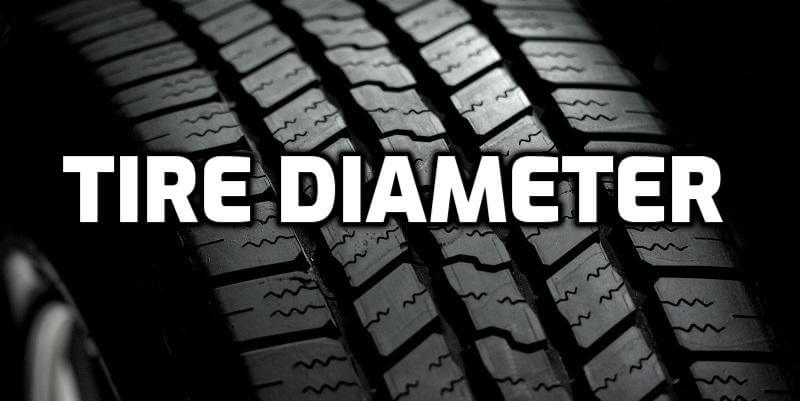Understanding Tire Diameter

Tires play a crucial role in a vehicle’s performance, safety, and comfort. Among the many factors that contribute to these characteristics is tire diameter, which significantly impacts vehicle dynamics.
This article will delve into the role of tire diameter in vehicle dynamics, the process of calculating it, the factors that influence it, and how to choose the correct tire diameter for your needs.
Tire Diameter’s Role in Vehicle Dynamics
Tire diameter plays a significant role in a vehicle’s dynamics, particularly in its speedometer accuracy, acceleration, braking, and handling.
Influence On Overall Tire Size
Tire diameter, which is the distance between the tire’s outer edges when inflated, affects the overall tire size. The larger the diameter, the bigger the tire, which can impact the vehicle’s overall dimensions, wheel well clearance, and suspension system.
Impact On Traction And Grip
A tire’s diameter plays a role in determining the amount of traction and grip it can provide. In general, larger-diameter tires offer better traction and grip because they have a larger contact patch with the ground. However, it is essential to strike a balance, as excessively large tires may negatively affect vehicle handling and fuel efficiency.
Effects On Ride Comfort And Handling
The tire diameter can also affect a vehicle’s ride comfort and handling. Smaller diameter tires typically offer better handling due to their reduced sidewall height, which reduces flex during cornering. On the other hand, larger-diameter tires can provide a more comfortable ride by absorbing road imperfections more effectively.
Rolling Resistance And Fuel Efficiency
Tire diameter is directly related to rolling resistance, which affects a vehicle’s fuel efficiency. Generally, smaller-diameter tires have lower rolling resistance and better fuel efficiency.
While larger-diameter tires have higher rolling resistance and reduced fuel efficiency. It is important to consider this trade-off when selecting tire diameter for your vehicle.
Calculating Tire Diameter
To calculate the diameter of a tire, you need to measure the distance from the ground to the top of the tire’s tread. You will also need to know the tire’s aspect ratio, which is the height of the sidewall as a percentage of the tire’s width.
- Locate the tire size information on your tire’s sidewall, which is typically displayed as a series of numbers and letters (e.g., 225/50R17).
- Identify the section width (first number), aspect ratio (second number), and rim diameter (last number, preceded by an “R”).
- Convert the aspect ratio to a decimal by dividing it by 100.
- To determine the tire’s sidewall height, multiply the section width by the aspect ratio (in decimal form).
- Multiply the sidewall height by 2 and add the rim diameter to calculate the tire diameter.
Example: 205/55R16
- Section width = 205mm, aspect ratio = 55, rim diameter = 16 inches
- Aspect ratio in decimal form = 0.55
- Sidewall height = 205 * 0.55 = 112.75mm
- Tire diameter = (112.75 * 2) + (16 * 25.4) = 25.4mm * 24.5 = 622.3mm
Importance Of Accurate Calculations
Accurate calculations of tire diameter are crucial for several reasons:
- They help ensure proper fitment on your vehicle, avoiding potential issues with wheel well clearance and suspension components.
- Precise tire diameter measurements contribute to optimizing traction, handling, and fuel efficiency.
- Accurate calculations are necessary for maintaining your vehicle’s overall performance and safety, as incorrect tire diameters may negatively affect these aspects.
Factors Influencing Tire Diameter
There are several factors that can influence the diameter of a tire, including:
Tire Construction And Materials
Tire diameter can be influenced by the construction and materials used to make the tire. Different tire types, such as radial or bias-ply, can have varying diameters even when the same size is indicated on the sidewall. Additionally, the rubber compound and reinforcing materials used in the tire can affect its diameter.
Tire Wear And Age
Over time, tire wear and age can alter the diameter of a tire. As the tread wears down, the tire diameter decreases, which may impact vehicle performance and safety. Regular tire inspections and timely replacements are essential to maintaining optimal tire diameter.
Load Capacity & Inflation Pressure
The load capacity and inflation pressure of a tire can also influence its diameter. Underinflated or overloaded tires can cause the sidewalls to bulge, effectively reducing the diameter. Maintaining proper inflation pressure and adhering to your vehicle’s recommended load capacity is essential for preserving the optimal tire diameter.
Considering Local Weather & Road Conditions
Local weather and road conditions should also factor into your tire diameter decision. Larger diameter tires can offer better traction and grip on slippery surfaces in regions with harsh winters or heavy rainfall. Conversely, smaller-diameter tires may suffice if you primarily drive on well-maintained roads.
Tips For Selecting
- Consult your vehicle’s owner manual for recommended tire sizes and diameters.
- Consider your driving preferences and prioritize the aspects most important to you.
- Take local weather and road conditions into account.
- Consult a professional tire dealer or mechanic for personalized advice.
Conclusion
Understanding tire diameter is essential for optimizing your vehicle’s performance, safety, and comfort. By considering factors such as vehicle dynamics, tire construction, wear, and load capacity, you can make informed decisions when selecting the right tire diameter for your needs. Consider your vehicle’s owner manual and seek professional advice to ensure the best possible outcome for your tire selection.

